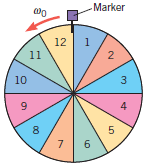Arif Emre E. answered • 05/04/19
PhD in Physics with 15+ years of Teaching Experience
For the angular kinematics with constant angular acceleration you can use
Δθ=ω0t+0.5αt^2 and ω=ω0+αt
Here in your problem, α is negative since the wheel is decelerating.
For part a, then, we have following equations:
Δθ=0.920 t – (0.5) (0.281) t^2 and ω=0.920 – 0.281 t
Using the latter, you solve for the time it takes for the wheel to come to a halt. This is when ω=0, which gives you t=0.920/0.281=3.27 seconds. Inserting this value in the first equation, you get
Δθ= (0.920)(3.27) – (0.5)(0.281)(3.27)^2 = 1.506 revolutions = 1.506 rev x 360o/(1 rev)= 542.16o
So, the net angular displacement becomes 542.16o – 360o = 182.16o . And this corresponds to the 7th section. (182.16 / 30 = 6.072 > 6 ⇒ 7th section)
For part b, you do the exact same calculation using 2.24 rev/ sec instead of 0.920 rev / sec. I found Δθ=334.08o (as the net displacement) and this corresponds to the 12th section. (334.08/30 = 11.136 > 11 ⇒12th section.)






